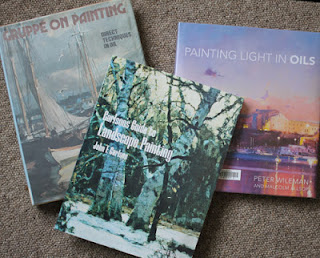I’ve always loved educational books. I’ve never been a reader of novels but give me a text book on an interesting subject and I’m happy.
In the last few weeks I’ve had my head stuck in three books in particular. The first is titled Gruppé on Painting: direct techniques in oil, by Emile Gruppé. I ordered this one through my local library after finding it on LISWA, a searchable database of the Western Australian public library system.
The second is Carlson’s Guide to Landscape Painting by John F Carlson. LISWA didn’t list this one so I ordered it through my local book shop.
The third is Painting Light in Oils by Peter Wileman. Although published just last year, I found this one on LISWA too – it’s in brand-new condition!
Both Gruppé and Carlson are recommended by artists whose work I’ve come to respect. Carlson, in particular, is often referenced by contemporary landscape painters. Both these books are pretty old.
Gruppé was published over 30 years ago and is mostly in black and white print with two sets of colour plates of selected paintings. Printing has come a long way in thirty years and I’m certain these aged reproductions do the originals no justice at all. That said, the book is chock full of easy-to-read advice for the landscape and seascape painter. I read it from cover to cover in a matter of days (a record for me). If I didn’t have to return it, I’d certainly refer back to it. The only drawback is that many of Gruppé’s examples are based on old, busy fishing boat harbours that, whilst interesting, might seem a little irrelevant to some readers. I found myself wishing there were harbours like those somewhere near here. Our nearest fishing boat harbour is pristine and deserted by comparison.
I bought Carlson’s Guide because I keep seeing and hearing references to it and, quite frankly, it’s cheap. It cost me $16 at an actual shop but it’s even cheaper if you’re happy buying online. This book has no colour whatsoever, except for the cover. Reviews on Amazon suggest some people are disappointed by this but the book was first published in 1929 (I think that’s just after paper was discovered, wasn’t it?). It was revised in 1958 and although the current book was published in 1973, it’s a copy of the ’58 version.
I’m finding Carlson a little harder to read than Gruppé. It’s by no means difficult but Carlson is a little more, err, “old fashioned”. That said, this book is also full of advice and information, especially for the plein air painter. The sample paintings and discussions in the book may be a little more relevant to the landscape artist than Gruppé’s largely harbour-centric advice.
The lack of colour in these books should help to press home the central message of both authors that tone, or value, and composition are the main game and that the artist should do what it takes to make these things work. Colour is just the icing on the cake, the roof on the house, the fluffy dice hanging from the rear vision mirror.
The third book is by Peter Wileman, current president of the Royal Institute of Oil Painters. Exploiting advances in printing technology in recent years, there is absolutely no shortage of colour in this book – not only is there a colour plate on every page, but Wileman’s paintings themselves are loaded with colour. The advice in this book is largely based on descriptions of how selected paintings were approached. It is not a Gruppé- or Carlson-style text book. I was interested to note that, like me, Wileman works on MDF panels primed with acrylic. However, while I use a proprietary acrylic gesso, Wileman gives a recipe for his primer that I was previously unfamiliar with. I’m going to give it a try myself soon. If it’s good enough for the president of the ROI, it must be good enough for me. I’m adding this book to my shopping list because it is simply beautiful and I like owning attractive and informative books. Amazon lists it at under $20, which seems somewhat under-priced for a book of this quality, so I might have to dip my toe in the water and try Amazon for this one.
UPDATE:
You can preview the Carlson book at Amazon.


Thanks for the book reviews! I was considering the Gruppe book but if it's as "harbor centric" as you say it is, I think I'll skip that one.I like some of the paintings in Carlson's book but find it rather a non-enjoyable read mostly because I find he's wordy and as you put it: "old fashioned" in writing style. I've got Peter Wileman's book on the way- hope it's a good one! Greetings from Canada !
I wouldn't want to put you off. I'm glad I read Gruppé, despite the harbour scenery. I might not pay a lot of money to own it but if I see it at a secondhand book sale, I'll snap it up. It is a much easier read than Carlson, in my opinion.
Carlson just requires a little patience. I've put it aside for a while but it's still there, taunting me to continue. And I will.
Thanks for your comment. I think you'll like the Wileman book if you're familiar with his work already.